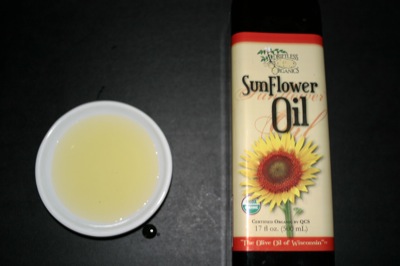Photo shows from left to right: Olive, Coconut, Toasted Sesame and Butter.
Look, its time we got over our fear of fats and started accepting them for the healthy, necessary part of our diets that they are. They are as necessary as any other element of food in order to have a nutritious, balanced diet. As a chef, I am able to see the value and deliciousness in all fats. As a realist, I understand that too much of anything can hurt you and that of course, there are some things it would be best not to form a habit around. See, I can appreciate a piece of baguette dipped in extra virgin olive oil AND a glazed donut fried and dripping in who knows what blend of hydrogenated and processed oils.
It is with this in mind that I have decided to tackle the often confused and maligned world of fats and oils while hopefully offering some fun culinary insights to the uses of the myriad oils available to us in our modern, global world.
To begin, I'd like to clarify how I view fats. First, I find it useful to avoid the complications of saturated and unsaturated with all of the poly-mono-trans talk. It is interesting and understanding it has merit, but it tends to be ever changing and a bit confusing, due to the particular slant of any one argument. I prefer to look at fats as animal/vegetable and refined/unrefined. I also find it useful to know just a little bit about the "smoking point". I'll explain why and then share my favorite oils below.
First, perhaps I should just say a word about why I think fats are part of a "healthy, balanced" diet. Fats are an essential in cellular health, from helping to build strong cell walls, to acting as carriers for fat soluble vitamins, such as A, D and E. The best way to get these and more benefits from fats is in their most pure, unprocessed forms. This means a diet that is rich in nuts, seeds, legumes, and raw oils such as olive oil and butter. Fried foods are delicious, you don't need to convince me of that, but those refined, processed and heated oils are not the ones that are going to provide you with the needed benefits.
So, why do I differentiate between animal and vegetable fats? Primarily because I believe that the majority of vegetable fats are not healthy except in moderation. Of course, there are exceptions, but for the most part, almost all vegetable oil sold in our country has been refined in some way. If it hasn't, chances are that it is not terribly useful in cooking. Animal fats on the other hand, tend to be very stable and have high smoking points and contain high amounts of fat soluble vitamins A, D and E. Cooking with the right fats will reduce the amount of free radicals and otherwise unstable elements that you introduce into your body.
The unrefined vs. refined issue is perhaps the most important to me. Fats tend to be extremely stable in their raw forms, but once they are refined, they contain much higher levels of free radicals. The fat soluble vitamins are often compromised when exposed to heat. Then add the fact that much processing involves adding chemicals to help extract the oils and sometimes even more chemicals to clean and then bleach the oils and the end product can be a bit of a tasteless mystery. I prefer to consume high quality refined oils that have an explanation of their process and then, only in moderation.
Finally, we come to the discussion of the "smoking point" of oils. This is a very useful and easy idea to understand. Basically, when the oil begins to smoke, it is breaking down and becoming unstable. You do not want to push your oils to this point if not for your health, then for the flavor. If you have ever left an oiled pan on, been to slow to add vegetables to your wok or had the griddle too hot when making pancakes, you know about the smoking point.
As a general rule, the smoking point for all oils is higher if they have been refined and animal fats almost always have a higher smoking point than vegetable oils. The only unrefined vegetable oils with a fairly high smoking point (350 or more) are coconut, sesame, and olive oils. This is great for pan frying, but for deep frying still may be problematic. Lard and other animal fats tend to be 375 or higher and clarified butter (ghee) is fantastic for frying, with a smoking point of almost 500.
Ok, enough already! What I really want to do is to share some of my favorite oils, so here goes...
Butter:
I know, that should be obvious, right? I absolutely love butter and when you add to the fact that it is local and if you buy the deeper yellow butters made from farmers who feed their cattle well, your vitamin consumption will be great. Plus, when you take the extra time to make clarified butter, you have a delicious and viable frying oil too!
Olive oil:
Extra virgin olive oil is just a treat. I love to dip bread and pizza crusts in it, but more than that, it is my number one oil in terms of how much I use. It goes into salad dressings and in stir fries and often in my fried potatoes. I've also become quite the fan of adding a tablespoon or so to tuna salad, chicken salad or potato salad.
Coconut oil:
Yes, I hopped on the coconut oil bandwagon and am now converted. I don't use it nearly as much as the above oils, but it has a fairly prominent spot on my cooking shelf. I think my favorite use is for popcorn. I still make popcorn in a cast iron pan or soup pot and the coconut oil is a great flavor compliment to popcorn. I also love to make pancakes, stir fries and sometimes fried potatoes with coconut oil. It can be delicious in granola! Be sure to watch out if this oil is new to you...the flavor is very strong and you will definitely taste it...and if you are me, lick it off of your fingers.
Bacon grease, lard: (and soon perhaps chicken or duck fat)
I was born in the south and love thinking about my grandparents and even my parents who always had a coffee can of bacon fat under the sink. The tradition continues with me and I find myself using it to fry greens, onions and eggs. I also add it to the cooking vegetables and meats of certain soups and stews. As a matter of fact, just the other day, I opened up an old Louisiana cookbook to make jumbalaya and the recipe called for 4 T bacon grease!
Sesame or toasted sesame oil:
I love sesame oil for stir fries and salad dressings and primarily use the toasted varieties.
Peanut oil:
Not sure why, but I love a little peanut oil now and then. This is the oil I use for high heat frying and I am sure it is probably nasty stuff, but when I want to make fritters, fries, or fried chicken, peanut oil makes it delicious. Be careful if you are serving guests due to peanut allergies.
 Driftless organic sunflower oilSunflower oil:
Driftless organic sunflower oilSunflower oil:
I recently discovered cold-pressed, Wisconsin grown sunflower oil made by Driftless Organics and when I enquired about it, owner Josh Engel gladly sent me a bottle. It is delicious and fresh tasting and has now become a new staple for dipping bread, pouring on salads or for using in salad dressings.
Nut oils:
I like to keep a few raw nut oils in the fridge primarily for dipping or salad dressings. They are unique and delicious. Just watch out for allergies if you are serving guests.
Truffle oil:
How can I leave out this little beauty. An absolute must if you want to add a little sneaky punch to a dish. Expensive, but add just a teaspoon or less to something and watch how it is transformed with earthiness and mystery.
Sourcing:
I source my oils from all over, but mainly from food cooperatives and international grocery stores. Greek grocers have a great selection of olive oil and often have many nut oils. Asian markets will have peanut and sesame oils, not to mention many more. Indian groceries have ghee, coconut, palm and mustard oils to name a few. Coops will have a bit of everything, but especially a great selection of amazing butters and unrefined oils.
Making clarified butter (ghee)
-Butter is made up of butterfat, milk solids and water. By clarifying the butter, you will effectively remove most of the milk solids and water, leaving just the butterfat.
-First, very gently melt unsalted butter in a sauce pan. Check the butter occasionally and as a white foam begins to form on the top, spoon it off.
-Prepare a bowl or glass measuring cup with a strainer and/or cheesecloth.
-Pour through strainer to separate any milk solids that could not be strained off or sank to the bottom.
-Ghee keeps extremely well, but if you don't plan to use it in a month or so, place it in the fridge.
Hope this helps to clear the fatty fog a bit and inspire you. Share your thoughts, concerns and ideas below and help keep the conversation moving.
For additional reading:
Nourishing Traditions cookbook by Sally Fallon and Mary Enig has an astounding amount of information on fats and really...everything.
Learn more about smoke points on Wikipedia.

Lawrence Black is a writer and editor at Simple, Good and Tasty. He can be reached at lawrence@simplegoodandtasty.com.




